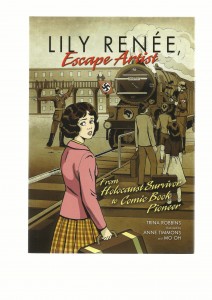Lily Renée, Escape Artist; From Holocaust Survivor to Comic Book Pioneer
Reviewed by Will Morgan 02-Feb-12
Lily Renée is one of a largely unsung legion of women who by their example offer the answer to the question, “Why aren’t there many women comics creators?”. Said answer, of course, is: “They’re out there; and moreover, they always have been, for as long as the medium’s been in existence.”
“Who is Lily Renée, and why should we care?” I can hear the average comic-shop denizen muttering. Well, Lily Renée is one of a largely unsung legion of women who by their example offer the answer to the question, “Why aren’t there many women comics creators?”.
Said answer, of course, is: “They’re out there; and moreover, they always have been, for as long as the medium’s been in existence.” But their identities have been hidden, their contributions undervalued or unnoticed. Often they were the wives, daughters or sisters of male artists and writers, roped in to lend a hand with crunching deadlines and discovering they had a flair for the work.
But also, frequently, the unrelenting chauvinism of the field persuaded women who worked in it to adopt male or neutral pseudonyms, obscuring their gender unless and until their creations became popular enough to cause readers to overlook the lamentable fact of their womanhood. (Dale Messick and Tarpé Mills, with Brenda Starr and Miss Fury respectively, hit big enough to come out of the ‘linen closet’, but scores more women remained panelological drag kings for the bulk of their careers.)
Trina Robbins, Hera help her, has devoted much of the latter half of her career to ensuring that these women are properly acknowledged, and among her most recent efforts is this younger-readers graphic novel in an educational series devoted to women’s achievements.
In 1938, Lily Renée Wilhelm was a 14-year-old Jewish girl in Vienna; her parents were educated and affluent, and the young Lily’s life was filled with art and culture. Then the Nazis marched in, and her life, like so many others, was irrevocably shattered.
To survive, she fled on the Kindertransport program to England, leaving her parents behind, but then had to escape many more times, from servitude, danger and betrayal, ending up in New York, where, now the sole support of herself and her rescued parents, she worked several jobs, including commercial illustrator and clothing model, before approaching Fiction House – one of the few comics companies that employed a number of women (Ruth Roche, Fran Deidrich, Nina Albright), and minorities (Matt Baker, the best-known ‘Good Girl Artist’, whose Afro-Caribbean ancestry remained secret from his fans for many years).
Lily knew nothing of this, and it was blind luck and a randomly-purchased issue of Jungle Comics which led her to the company where her gender was least likely to disqualify her. At first doing drudge work – error erasing and backgrounds – she graduated to Werewolf Hunter, where she livened up boring scripts by dressing the women in the latest fashions that Lily herself had modelled, and aviatrix Jane Martin, before being handed her signature strip, Senorita Rio, about a Brazilian nightclub entertainer who doubled as a spy, wore sensational outfits, and regularly kicked Nazi ass with her stylish high-heeled pumps!
After her marriage, Renée moved on to textile and jewellery design, writing and illustrating children’s books, and the authorship of five plays; but she retains, to this day, in an elegant retirement, gratitude for Senorita Rio and the other comic-book ladies who helped her, as a struggling artist and refugee, indulge her fantasies of revenge against her oppressor – and get paid for it!
Robbins tells Lily’s story with an admirable clarity and balance; mindful of her young audience, she eschews explicit and gory detail while not shrinking from the duty of educating her readers about the horrors of the Holocaust. Much of the book is devoted to Lily’s early biography, her comic-book work only coming in on the last segment, and Lily’s strengths and flaws are both equally depicted.
Illustrators Anne Timmons and Mo Oh are stylistically reminiscent of Robbins’ own earlier work; their clean, efficient art moves the story along briskly and will appeal greatly to their intended readers. The narrative style here may sometimes be too sedate for the comics audience, but it must be remembered that the team worked under the constraints of an educational brief, to be distributed to schoolchildren who aren’t necessarily familiar with the ‘rules’ of comics reading, so zappy layouts and clever panel continuity would possibly be confusing. But, if you read without allowing the simplified storytelling to prejudice you, it’s entertaining and informative.
(ISBN 9780761381143)
Tags: Anne Timmons, Graphic Universe, Lily Renee, Mo Oh, Trina Robbins

What a delightful review. What an elegant portrait. Trina, you are always first class.